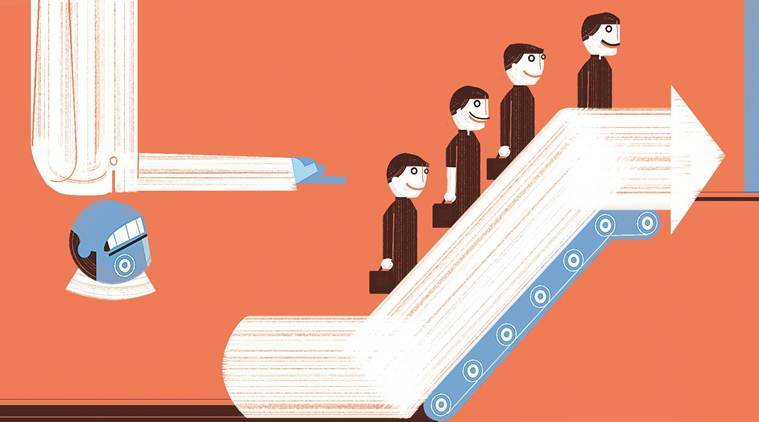Job gains versus fake analysis
Let us debate facts or close approximations. Let discussions on government’s economic performance rise above the unintelligent discourse that passes for analysis

Illustration by C R Sasikumar
It is election season — but isn’t that always the case in India? However, what is new is that the forthcoming national election is likely to be the most contentious, and given that it is 2018, likely to have the most WhatsApp and other fake baggage.
Sometimes Indians are shy about their inventions, but not so the Americans who proudly proclaimed to the rest of the world that they, via the 2016 election that brought Donald Trump to office, had invented fake news and its use in election campaigns. Even a cursory perusal of the Indian elections over the last four years will convince any sceptic that the “trophy” belongs to India, and its politicians and journalists.
Consider the following pieces of evidence. Cash is back, or so we are told. What are the facts? At the time of demonetisation, cash with the public, average for July-September 2016 was Rs 16.6 trillion) In my article (‘Black Cash in India’, IE, December 6, 2016), I had compared the level of currency with public in India as a percentage of cash and demand deposits (M1), and showed that at 62 per cent, this was some 17 per cent above the norm for developing economies. In 2018 Q1 (latest quarterly data, 2018Q1) cash was at Rs 17.1 trillion. Taken as a ratio of M1, however, this is at 56 per cent for the latest quarter (2018Q1) down by 8 per cent from the pre-demonetisation quarter (2016Q3). Similar calculations for GDP suggest that from being 13.4 per cent of the GDP in 2016Q3, it is now 11.3 per cent, or a decline of 16 per cent. In other words, cash to GDP levels in India today are 16 per cent lower than before demonetisation. Yet, journalists continue to peddle the news that cash is back, and, therefore, demonetisation failed.
Just casual observation (forget ingenuity) will lead you to the conclusion that such “news” is being orchestrated as part of the political opposition’s campaign. The logic is that Narendra Modi was elected on a campaign promise of improving the economy (vikas) and since that hasn’t happened (according to the opposition data “experts”), there is no reason to vote for Modi — that is vote for Congress, or Mahagathbandhan, to get the mojo (and the old “glory”) back.
It seems that the Opposition will go the most brazen lengths to prove their fake conclusions. For example, no less an expert as former Finance Minister P Chidambaram wrote the following about Budget estimates for 2018/19: “Based on revised estimates, it appears that … GST (revenue) will grow at a whopping 67 per cent. Notwithstanding the doctor’s concerns, a very ill person has left an aggressive will” (‘Across The Aisle: Good doctor, bad patient’, IE, February 4).
How did the Opposition expert get the astounding figure of 67 per cent growth in GST revenues? Simply divide the 12-month GST revenue estimate for 2018/19 by the eight-month GST revenues collected in 2017/18, and voodoo economics will yield a 67 per cent gain.
Another Cambridge Analytica-inspired favourite of the “experts” is that GST has been heavily flawed in its implementation. At other times, the Opposition states that the GST has been good, but it was UPA’s idea. But you have to have a forked tongue to make both claims. Regardless of whose idea it was (and there is a genuine debate on the subject), the fact remains that the UPA did push it strongly, and the BJP did oppose it when they were not in power. Sad.
Today, I would emphasise, as the outgoing Chief Economic Adviser Arvind Subramaniam has done, that the revenue garnered by the GST has exceeded all expectations with a tax buoyancy of 1.2 rather than 1 — that is, indirect type taxes normally increase at the same rate as nominal GDP. What is remarkable is that the GST tax revenue has increased at a rate 20 per cent faster than traditional indirect taxes. And that was in the first eight months of implementation, when, we all recognise, implementation problems were immense. But we, as argumentative Indians, should begin to learn to give credit when due.
Another fake-news favourite is that investment rates have declined and are now even below the low levels inherited by Modi. In 2013/14, investment as a share of GDP was 31.3 per cent — the latest data for 2017/18 shows that this share has declined to 28.5 per cent — almost a one percentage point decline for each year of the Modi government. The hidden (or squirreled away) fact from the discussion is the reality that the BJP inherited a broken state banking system (also known as very large NPAs) and that this may have led to the continuing decline in investment shares. A close perusal of the data seems to suggest that investments have done reasonably well, given the inheritance bequeathed by the UPA. The investment share in GDP in real terms (2011/12 prices) was 34.3 per cent in FY12, 32.6 per cent in FY14, and, after reaching a low of 30.3 per cent in FY16, it is now back to 31.4 per cent. A very different picture is painted by real investment rather than the flawed nominal share of investments.
Tirtha Das and I, in a detailed 45-page report available on the PMEAC website (‘All you wanted to know about Jobs in India — but were afraid to ask’, available at https://goo.gl/Y5CLtF; also on ssbhalla.org) present some findings on job growth in India, 1999/00 to 2017/18. This detailed analysis is based on all available data on employment (NSSO, Labour Bureau, Quarterly Economic Survey or QES, EPFO, and CMIE). There will be another occasion to discuss the findings in detail. Please be as critical of the conclusions as I am of other conclusions (some mentioned above). But let us debate facts, and causes, or close approximations thereof. Let us leave fake analysis to the trolls; they need to keep themselves occupied. Let Twitter, and newspaper discussions, rise above the unintelligent, and fake, discourse that presently passes for analysis.
What are the facts pertaining to employment in India post 2014, and especially post demonetisation — that is in 2017 (or 2017/18). Some employment facts about the past. First, for some strange reason, employment growth is the highest in the NDA periods. Between 1999/00 and 2004/5, jobs (principal status) increased at a rapid pace of 2.4 per cent a year, or an average annual job gain of 9.7 million jobs. GDP growth averaged 5.6 per cent a year. In the UPA period coincident with the NSSO data (2004/5 to 2011/12), GDP growth averaged the highest ever, CAGR of 7.8 per cent a year (as also inflation — a CAGR of 7.4 per cent — but that story can be told on another day). However, employment, (principal status), increased by only 11 million; according to the weekly status, employment increased by a similar 11.4 million.
This was the employment creation inheritance of PM Modi. And before the economy could really get started, it was hit by two successive droughts in 2014/15 and 2015/16. This is only the fifth time in history (IMD data from 1871) that this has happened — previous years being 1876-77, 1904-05, 1965-66, 1986-87, and 2014-15. Droughts are not good for employment.
From 2016 onwards, we have three independent but piecemeal sources of data on employment growth — QES, CMIE and EPFO. The NSSO data for 2017/18, when released, will be the arbiter of the accuracy of various employment estimates. For the record, the private sector CMIE-BSE data is the most pessimistic showing a loss of 2 million jobs in 2017. The raw CMIE data (unadjusted by Census population estimates for 22 age-sex groups for both men and women) shows a total job gain of 1.4 million. But this is incorrect since the survey population in each age-sex cell is not a good estimate of the Census population in each age-sex cell (see the paper for details).
If the QES data are extrapolated to the entire non-farm population, job growth in India was 10 million; EPFO based estimates place it at 7 million; our estimate for 2017 (CMIE data) is a job gain of 12.8 million. We are ready for the NSSO judgement on our accuracy, as should all the others.
The writer is a senior India analyst at Observatory Group, a New York-based macro policy advisory group, and part-time member of the PM’s Economic Advisory Council. Views are personal.
For all the latest Opinion News, download Indian Express App
More From Surjit S Bhalla
- India is middle income now: Raise the poverty lineRegardless of the poverty line used, it appears that India is on track for the fastest pace of poverty reduction in the period between 2011/12…
- Let the elite payTo reform education system, provide a level playing field, regardless of caste, sex, or income. Stop subsidising higher education for the rich. ..
- Inflation, not yet viralPronouncing the rebirth, or even significant acceleration in inflation, may be a trifle premature..







































No hay comentarios:
Publicar un comentario